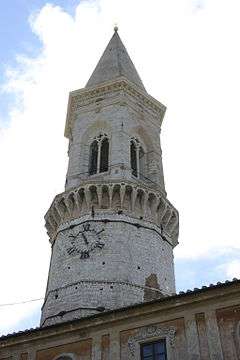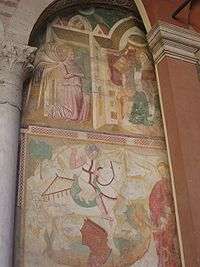San Pietro, Perugia
San Pietro is the name of a church and an abbey in the city of Perugia (Umbria), central Italy.

History
The monastery was created around 1002 over the former cathedral church, the early seat of Perugia's bishops, existing since the early seventh century, although the first document citing the abbot is from 1002. Its early patron was Pietro Vincioli, a Perugian noble, later canonized.
In the following centuries the abbey increased greatly its power, until in 1398 it was burnt by the Perugini, as the abbot Francesco Guidalotti had taken part in the plot against Biordo Michelotti, chief of the popular party. The monastery reflourished with Pope Eugene IV, who united it to the Congregation of St. Justine of Padua, maintaining a position of prestige and power in the city.
The abbey was temporarily suppressed by the French in 1799. The monks had aided the Perugine revolt of 1859 against the Papal government, and, after the Unification of Italy, the new government allowed them to remain in the Abbey.
Buildings

The monastery is preceded by a 15th-century gate designed by Agostino di Duccio that leads to a monumental facade with three arcades, designed around 1614 by the Perugine architect Valentino Martelli: the first cloister is also by Martelli, with the second floor completed by Lorenzo Petrozzi.
The entrance of the church is on the left side of the cloister. Remains of the facade of the ancient basilica can be seen on the left and the right of the fifteenth-century portal, with a portico including some frescoes from the 14th and 15th centuries. The polygonal belltower, on the right of the portal, was rebuilt in 1463-68 with Florentine-Gothic lines, based on a design by Bernardo Rossellino).
The interior has a basilica plan, with a nave and two aisles. It has the most important collection of art in Perugia, after the Galleria Nazionale dell'Umbria. The nave is articulated by arcades on antique grey marble columns, probably coming from Roman constructions. The upper part is decorated with canvas depicting scenes from the Old and New Testaments, commissioned by Abbot Giacomo da San Felice da Salò and completed in 1591-1611. They were executed in Venice by Antonio Vassilacchi, a pupil of Paolo Veronese and Tintoretto. Also by Vassilacchi is the great canvas on the west wall, with the Triumph of the Benedictine orders. The central nave has a richly inlaid and colored coffered ceiling of wood by Benedetto di Giovanni da Montepulciano (1556)
Other works of art include works by Ventura Salimbeni, Eusebio da San Giorgio, Orazio Alfani, copies after Perugino, Girolamo Danti (sacristy, 1574), Giovanni Lanfranco, Mino da Fiesole (a marble with Young Jesus, St. John the Baptist and St. Hyeronimus, in the Vibi Chapel), a Jesus in the Orchard attributed to Guido Reni, two grand canvas by Giorgio Vasari, and a Pietà of Sebastiano dal Piombo's school. By Perugino himself is a series of Saints in the sacristy, once part of the San Pietro Polyptych (1496-1500), which once decorated the main altar of the church, and is now divided into several collections (the main panel is at the Museum of Fine Arts of Lyon).
The main feature of the presbytery (rebuilt by Martelli and decorated with works of art mainly of the late 16th century) is the intarsia of the wood-panelled choir, considered one of the most beautiful in Italy. It was begun by Bernardino di Luca Antonini in 1525-26, and completed by Stefano di Antoniolo Zambelli, from Bergamo, in 1535. Particularly noteworthy is the central door, with a relief portraying the Annunciation and Moses Saved from the Water by fra Damiano da Bergamo (1536).
The Abbey has two more cloisters: one, called Chiostro Maggiore, is a Renaissance construction attributed to Guido da Settignano, another, also known as Chiostro delle Stelle, is from 1571.
In front of the Abbey is the Giardino del Frontone, a former parade square of Braccio da Montone rebuilt into a garden with a tiny amphitheater by the Alessi family in the 18th century.
| Wikimedia Commons has media related to San Pietro (Perugia). |
See also
References
- Francesco Federico Mancini, Giovanna Casagrande, Perugia. Guida storica-artistica, Italcards, Perugia.
- Touring Club Italiano, Guida d'Italia: Umbria 1966, pp 109–10.